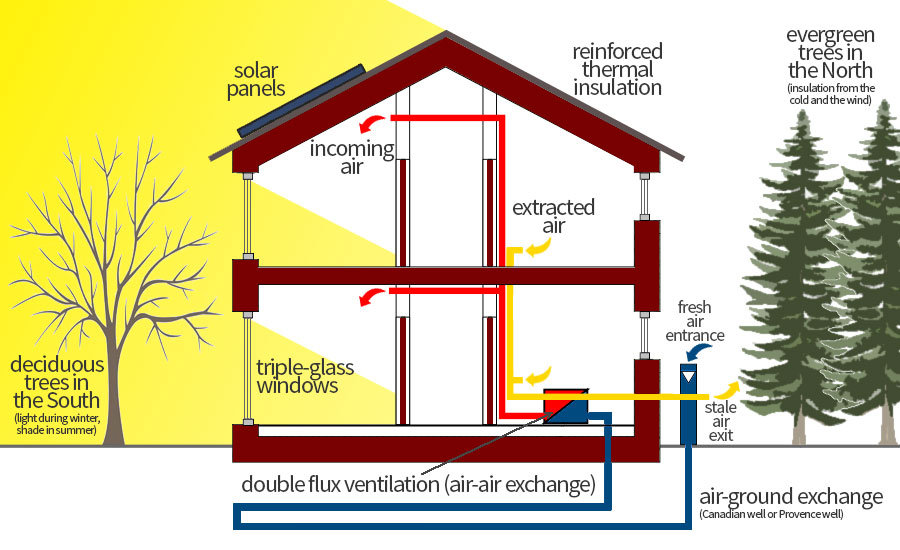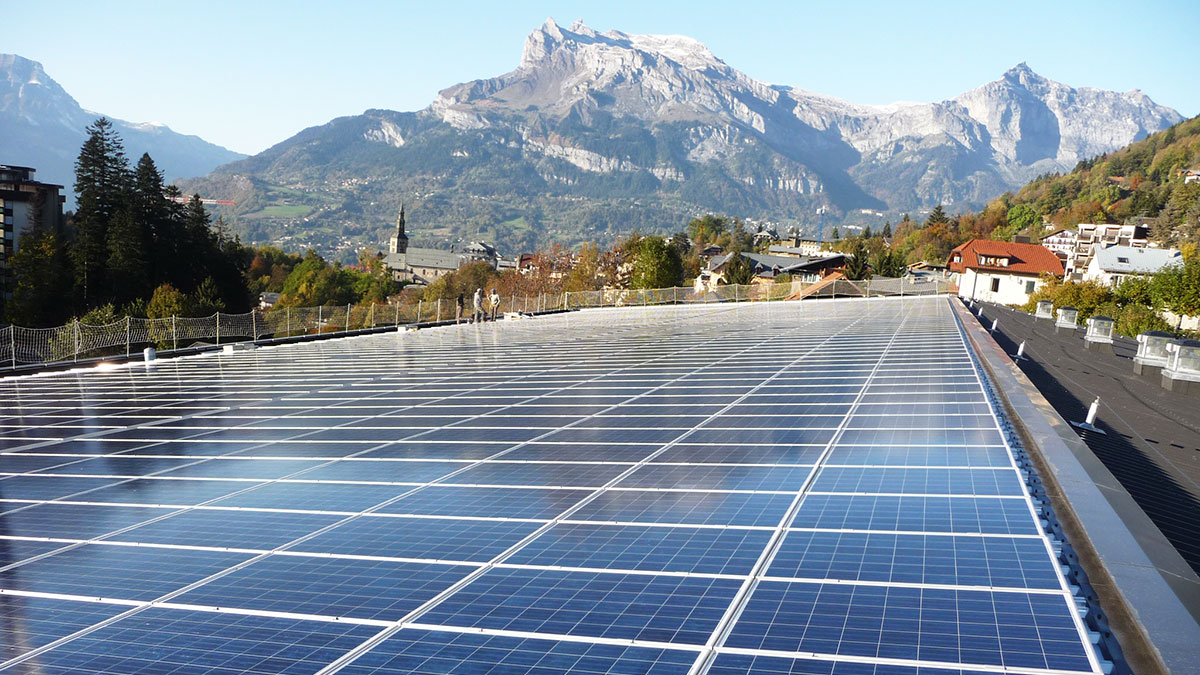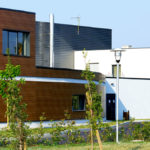The philosophy of sustainability in architecture is embodied through different practices that aim to reduce the negative impact of a house or building on its environment and to take care of the quality of life of its users and neighboring community. The implementation of a sustainable architecture is manifest with choices of techniques, methods of management, the selection of materials and the internal organization of functions and spaces, in order to control, in particular, the consumption of energy and the life environment of users.
The costs of ecological materials and facilities for sustainable architecture are often superior to conventional techniques, but the long-term savings often make these investments cost-effective. Moreover, the sustainable approach is strongly encouraged by the authorities of many countries with subsidies and tax exemptions that accelerate the amortization period of these investments and stimulate the construction of low-consumption buildings to improve the common living environment.
Energy management: the key issue in sustainable architecture
Controlling the energy consumption of a building is essential to the implementation of sustainable architecture. A set of practices minimizes energy losses, reduces requirements and potentially generates energy.
Thermal insulation
The most effective and least expensive way to reduce energy losses, good thermal insulation, is one of the keys to sustainable construction. Efficient insulation reduces heat dissipation in winter and heat entrance in summer; the energy requirements for heating and air conditioning are therefore reduced accordingly.
The reduction of energy losses will depend not only on the use of good insulation materials in structures and covering materials with high thermal inertia, such as wood, but also on a set of structural parameters: orientation of the building, water and air circulation, users and machines activity… It is however also critical to ensure an adequate ventilation when the insulation is effective.
The orientation of the building
The judicious design of a building according to the conditions of the terrain (sunshine, presence of forested areas, surfaces exposed to winds…) maximizes the input of natural energies and minimizes energy losses.
The installation of double or triple glass windows, which allow light to enter, but limits caloric losses, is a critical point for sustainable energy management by optimizing orientation and insulation. Louver shutters or sunscreens can also limit heat inputs in summer (when the sun is high) without hindering them in winter (when the sun is low).
The shape of the building
The total surface exposed to the outside is a factor of energy loss, therefore a building with an extended outer surface will tend to lose more heat (or gain heat in warm climates). It is thus necessary to favor a more compact form which increases the ratio between the volume of the interior spaces and the surface exposed to the weather and limits the heat losses.
Management of water, air and wastes
Another way to spare many energy losses. Energy transfers during wastes and wastewater disposal can be recovered and returned to the building by systems that heat water or clean air, such as heat pumps (see below).
For example, sorting, composting or methanation methods can be used to recycle organic wastes into natural fertilizers or gases. Dry toilets, rainwater collection systems for garden watering are all simple equipment that will limit the consumption of drinking water.
Heat recovery
Heat pumps are thermodynamic devices that enable heat exchanges between two different temperature environments, usually between the inside and outside of a building. A heat pump can be “geothermal” and capture heat from the ground to diffuse it into the building, notably for heating floors or domestic heating.
Geothermal pumps are generally more efficient, but other systems can also be used to exchange calories between separate heat zones, air-to-air, air-to-water or water-to-water with various uses: air heating, heating water for a swimming pool, cooling…
Energy production
The use of photovoltaic solar panels, or even photovoltaic cells directly integrated in the surfaces exposed to the sun is a good way to produce solar electricity. Solar water heaters can also be installed to produce hot water at low cost.
The inclination of the roofs where these equipment will be installed is then paramount to maximize the capture of the sun’s rays. Some buildings also present the possibility of being equipped with domestic wind turbines, but their efficiency is usually low.
These technologies, which generate electricity in the interiorof a building, reduce the need for external inputs accordingly. Depending on the functions and use of the buildings, some of these technologies can sometimes achieve energy balance or even a positive energy balance; this is called a positive energy building.
The vegetation
Planting deciduous trees is also an ecological solution to help regulate incoming sunlight while improving the quality of the air through natural photosynthesis. In summer, the leaves will serve as sunscreens, in winter the absence of leaves will not hinder the input of light. Evergreen trees can be used as external insulation against winter cold and wind on the north side.
Obviously, depending on the climate, certain elements of the energy strategy will predominate: for a colder climate the focus will be on heat and heat conservation; for a warmer climate, the emphasis will go to methods and materials to refresh the building and dissipate heat.
The following diagram represents the main principles for the architecture of ecological houses, but it can also be understood as a guide for the architecture of buildings.

The use of clean materials
The choice of materials is a preponderant element for the respect of the environment and nature. Particular importance must therefore be given to natural materials which use little gray energy (energy required for the production of materials) and which have a positive impact or at least do not harm the environment during their production.
Sustainable materials such as wood, stone, terracotta or certain plant products can be used in the structure, siding or roofing. However, sustainable materials are usually primarily used as insulation materials such as plant fibers, recycled fabrics or plastics, glass wool, cellulose wadding will provide a more environmentally friendly solution than synthetic materials.
In order to protect the health of users, sustainable construction will also minimize the use of toxic materials such as glues or paints, as well as materials with volatile organic compounds that can cause respiratory pathologies.
Sustainable urban planning
A building that would be located in the heart of nature will not necessarily be more environmentally friendly. This counter-intuitive truth is easy to understand: beyond the nuisance to the natural environment, the building will generate a higher energy cost to connect it to roads and utilities networks (electricity, telephone, water and sewage) and will also generate more pollution for the users’ longer comings and goings.
The optimal location would place a sustainable building in an already urbanized area occupied by diverse surroundings, with infrastructures favoring clean transport (pedestrians, cyclists) and low pollution (public transport).
Recycling of existing buildings
Significant savings can be realized through the redevelopment, renovation or reuse of existing buildings. Rather than systematically demolishing to rebuild completely new buildings, one of the primary considerations of sustainable architecture is the concern to recycle existing architecture.
Thus, even if existing buildings require renovation or heavy extensions, they can frequently allow significant energy, material and emission savings, in addition to the financial savings they most often provide.




